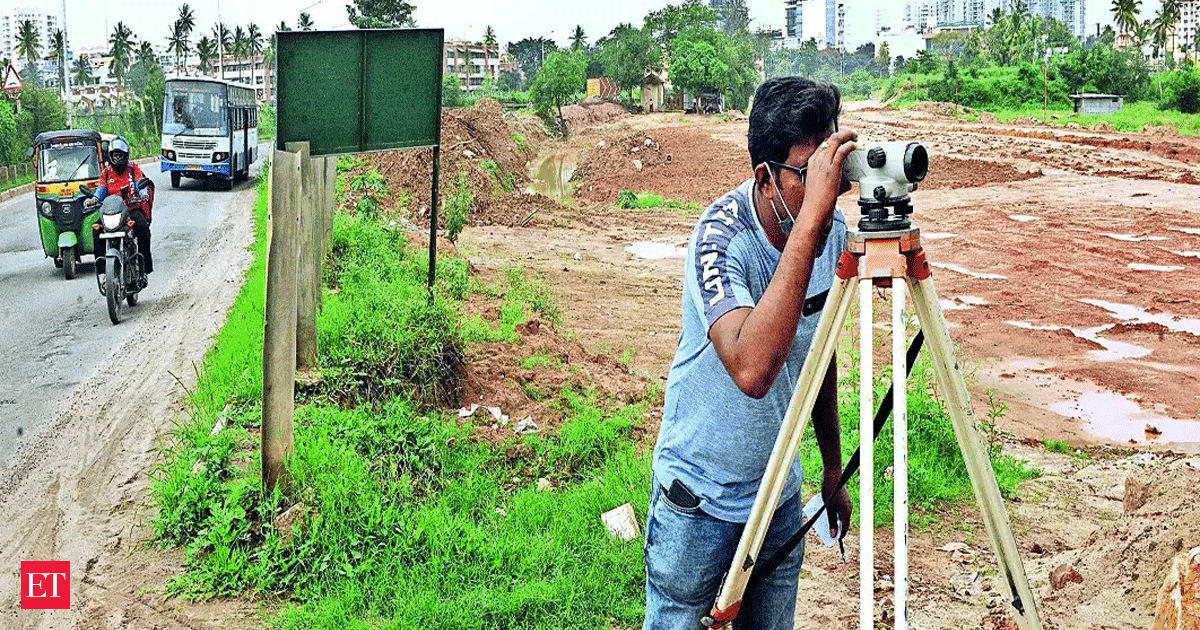By Land Resources Secretary
Copyright indiatimes

AgenciesRepresentative Image
In a significant step towards next-generation economic reforms, the Indian government is preparing to roll out a comprehensive, integrated electronic database of land records that will clearly delineate ownership rights across both rural and urban areas. This was confirmed by Land Resources Secretary Manoj Joshi in an exclusive interaction with ET. The initiative is being seen as a cornerstone of the government’s broader strategy to overhaul factor markets, particularly land and labour, following the successful implementation of GST rationalisation. It gains added urgency in the face of emerging global economic challenges, including heightened trade pressures from fresh US tariffs and broader geopolitical instability. In this context, Prime Minister Narendra Modi’s Independence Day speech this year, which emphasised the need for “next-generation reforms”, has set the tone for transformative policy action.A unified land information ecosystemThe government’s plan involves the creation of a nationwide, electronic land records database backed by cadastral maps, with the dual aim of ensuring clear ownership rights and enhancing real-time access to land data. This digitised platform will integrate disparate land records from across India, currently maintained by various departments and in varying formats, into a single, unified digital system.As per Joshi, rural digitisation is already nearing completion, with 379.29 million records, about 99.8% of available rural records, digitised. The remaining gaps are largely in the north-eastern states and the Union Territory of Ladakh. However, urban areas remain a challenge. Urban land records are currently available in a reliable and accessible format only in Gujarat, Maharashtra, and Tamil Nadu.To bridge this gap, a pilot project under the ‘Naksha’ initiative is underway in about 160 cities, aiming to collect and digitise urban land records. This exercise is expected to be completed within six months, after which the programme will be expanded across the rest of urban India. Drawing from the pilot’s findings, the government will build a model for standardised urban land digitisation.Why land digitisation mattersThis move is not just a bureaucratic upgrade but also a structural reform with profound implications for India’s economic efficiency, legal clarity, and investment climate. Land-related disputes are among the most common and complex legal conflicts in India. A transparent, verified and legally enforceable digital land record can dramatically reduce litigation and enhance legal security, especially for vulnerable landholders like farmers, tribal communities, and urban poor.Live EventsClear land titles are essential for infrastructure projects, industrial corridors, urban redevelopment and private sector investment. The lack of clean titles and unclear ownership is often cited by domestic and foreign investors as a major bottleneck. A unified database can reduce transaction costs, speed up project clearances, and attract capital. Real-time availability of ownership and usage data can help policymakers plan better land utilisation, whether for agriculture, industry, housing or ecological preservation. It also allows for smoother land pooling, acquisitions and urban planning.Accurate and verifiable land records can serve as collateral for loans, expanding access to formal credit for farmers and small landholders. This can have a direct bearing on rural livelihoods and entrepreneurship. A digitised land base also makes it easier to assess and collect property taxes, helping urban local bodies strengthen their revenue streams. This in turn can lead to better civic infrastructure and services.Fuelling India’s manufacturing and infrastructure ambitionsThis reform also has a strategic role in India’s economic transformation into a manufacturing and logistics powerhouse. Land is a critical factor of production, and the unavailability of verified, dispute-free, unencumbered land has long been a constraint in setting up factories, special economic zones (SEZs), industrial parks, and logistics hubs. With global supply chains shifting away from China, India is positioning itself as an alternative. To seize this opportunity, the government needs to offer plug-and-play industrial land, something only possible if ownership and usage rights are clearly defined and instantly verifiable.In addition, data centres, warehousing parks and e-commerce fulfillment hubs, all of which are central to India’s digital and consumer economy, require large, strategically located land parcels. A digitised, integrated land records system will streamline acquisition, zoning approvals and legal clearances for these sectors, cutting through bureaucratic opacity and delays.By making land markets more transparent and efficient, this reform will lower entry barriers, attract foreign and domestic investment and fuel job creation across manufacturing, construction and digital infrastructure.The urban puzzleWhile progress in rural areas has been commendable, urban land digitisation presents a more complex problem. Urban land is often entangled in layers of legacy ownership, informal settlements, fragmented inheritance and overlapping claims. Moreover, multiple agencies, from municipal corporations to development authorities, maintain parallel records, often in incompatible formats.The Naksha initiative, now being piloted, will offer critical learnings in urban geospatial mapping, record integration and dispute resolution mechanisms. Once scaled, it has the potential to bring transparency and order to India’s messy urban land landscape.Reform in the broader contextThe timing of this announcement is crucial. Following GST and the rollout of UPI, India’s digital public infrastructure is being globally lauded. The government now wants to apply the same transformative ambition to land and labour reforms, both historically contentious but economically essential. To shepherd this process, the Centre has set up two high-powered committees under NITI Aayog member Rajiv Gauba, tasked with consulting stakeholders and laying the blueprint for these reforms. This coordinated, top-down approach signals political will at the highest levels. ET has reported that the government is also planning to develop a labour market information system aimed at improving policy interventions related to employment and skills. The system, being jointly set up by the ministries of skill development and entrepreneurship, and labour and employment, will provide real-time information on labour market and availability of skill sets.India’s economic future rests on its ability to unlock the potential of its land, labour and capital markets. Among these, land reforms have long been the most complex and politically sensitive. Yet, without clean and accessible land records, land reforms can’t be meaningful or even possible. By committing to a comprehensive, integrated, and digital land record system, the government is laying the foundation for a modern, transparent and efficient land market which is essential for sustainable growth, equitable development and investor confidence.Add as a Reliable and Trusted News Source Add Now!
(You can now subscribe to our Economic Times WhatsApp channel)
Read More News onland resourcesunified land information ecosystemLand Reformselectronic database of land recordsGST rationalisationland and labourrural recordsurban land digitisationland digitisationtransaction costs
(Catch all the Business News, Breaking News, Budget 2025 Events and Latest News Updates on The Economic Times.) Subscribe to The Economic Times Prime and read the ET ePaper online….moreless
(You can now subscribe to our Economic Times WhatsApp channel)Read More News onland resourcesunified land information ecosystemLand Reformselectronic database of land recordsGST rationalisationland and labourrural recordsurban land digitisationland digitisationtransaction costs(Catch all the Business News, Breaking News, Budget 2025 Events and Latest News Updates on The Economic Times.) Subscribe to The Economic Times Prime and read the ET ePaper online….moreless
Prime ExclusivesInvestment IdeasStock Report PlusePaperWealth Edition123View all Stories



